|
|
 |
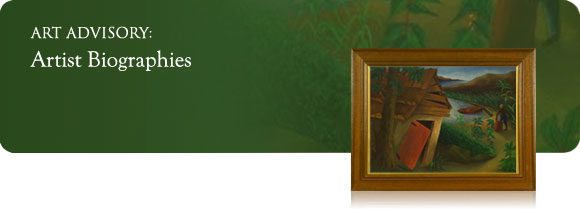
Alphabetical
A | B | C | D | E | F | G | H | I | J | K | L | M | N | O | P | Q | R | S | T | U | V | W | X | Y | Z
de Santamaria, Guillermo Silva Sanz
Sargent, John Singer
Sarsony, Robert
Sassone, Marco
Savage, Naomi
Schindler, Emil Jakob
Schneuer, David
Schoonhoven, Johannes Jacobus
Schwabe, Henry August
Sculthorpe, Peter
Segars, Mary Grayson
Semeko, Igor
Shatken, June
Shearer, Victor
Sheerboom, Andrew
Shonnard, Eugenie Frederica
Shoulberg, Harry
Shunney, Andrew
|
Simbari, Nicola
Siqueiros, David Alfaro
Sloane, Eric
Sloane, Marion Parkhurst
Slocombe, Frederick Albert
Soyer, Moses
Soyer, Raphael
Stadelhofer, Helmut
Stella, Joseph
Stern, Bern
Steynovitz, Zamy
Stobart, John
von Stoopendaal, Ferdinand
Straski, Abraham
Sully, Thomas
Summers, Ivan F.
Sunol Munoz-Ramos, Alvar
Swift, Jan
|
|
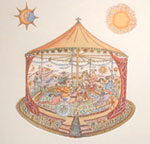
Guillermo Silva Sanz de Santamaria
b. 1921
Bogota Colombia
Guillermo Silva Sanz de Santamaria is a painter, sculptor, engraver, writer, and yoga teacher who was born in Bogota, Columbia in 1921.
|
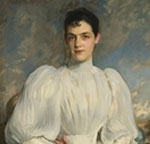
John Singer Sargent
1856-1925
American portrait painter
John Singer Sargent was one of America’s most important expatriate artists. All of his studies were abroad at the Academy of Fine Arts in Florence (1871-72), Ecole Des Beaux Arts (1874) and privately with Leon Bonnat and Carolus-Duran. His study under Carolus-Duran, whose work was fashionable yet adventurous, was a blend of brio and tightly handled Realism that deeply affected Sargent. He became a master of bravura brushwork in oils.
His portraiture, during the “Golden Age” of the late 19th and early 20th century, was in greater demand in high society than any other. Sargent’s work bears stylistic affinities with his contemporaries Whistler and Boldini, who together formed a triumvirate which became highly influential on an international scale.
By 1883 Sargent had hoped to expand his portrait trade but was hindered in Paris by the uproar over his painting “Portrait of Mme. X” (1884, Metropolitan). This work was an unsettlingly accurate portrayal of a notorious and exotic beauty which became rather scandalous. Therefore, Sargent moved to London in 1885 and stayed there until his death.
His career had peaked in the early 1900s; he had painted over 100 portraits, earned a substantial fortune and received many prizes and awards. He turned to landscape watercolor painting for pleasure and partially to avoid further commissions. These works resulted in beautiful observations with a glimpse of the dynamism between light and color. Sargent died in 1925 in London.
|
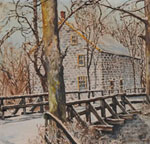
Robert Sarsony
-
New Jersey Regionalist painter/printmaker
Robert Sarsony is a self-taught painter and print-maker who began exhibiting in local shows in New Jersey in 1963. The following year he made his New York debut in a group show at Allied Artists. From 1969 until about 1974 he did a series of paintings based on book and magazine illustrations - "Pop Antiques," he calls them - from the 1920's through the 1940's. Subjects ranged from silent movie photographs and pictures of important historical events to reproductions taken from period children's books. In the corners of his canvases Sarsony often paints small images copied from cards found in cigarette packages and cereal boxes during the first half of this century. In doing so he follows in the steps of the nineteenth-century trompe l'oeil artists who depicted visiting cards that looked as though they were tucked under the edges of their paintings' frames. More recently Sarsony has portrayed figure and landscape subjects with an attention to light effects that gives his canvases an impressionistic air.
|
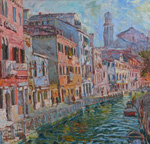
Marco Sassone
b. 1942
Italian American Impressionist-style landscape and canal scene painter
Marco Sassone was born in 1942 in Campi Bisenzio, Italy. He moved to Florence in 1954, where his interest in painting began. He studied architectural drafting at the Istituto Galileo Galilei, and sold his first watercolor sketches, to tourists. In November 1967, after a flood had devastated Florence, Sassone traveled to the United States, where he settled in California. In the early 1980s, he moved his studio to San Francisco, and here he sketched homeless people he met while observing life on the streets. From these sketches, he formed an exhibition entitled “Home on the Streets,” in 1994. It took place at the Museo Italo Americano in San Francisco, and traveled to Los Angeles and Florence, Italy. In 1982, Sassone was knighted by the president of Italy into the Order to the Merit of the Italian Republic, and he received a gold medal award from the Italian Academy of Arts, Literature and Science. In 2005, he relocated to Toronto, Canada.
|
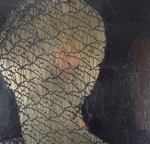
Naomi Savage
1927-2005
American, Princeton, NJ affiliated Modernist
Born in New Jersey, Savage studied photography with Berenice Abbott at the New School for Social Research in 1943, and studied art at Bennington College from 1944-47. Her trademark exploration of innovative techniques was influenced by an apprenticeship with Man Ray, her uncle, and further evolved amid increasing experimentation with alternative photographic, mechanical, and electronic processes throughout the 1960s and 1970s. Her approach represents an involvement with "process as medium," and an interest in art as image manipulation, a pursuit shared by contemporaries like Robert Heinecken, Betty Hahn, and Bea Nettles. Savage says that she has explored various techniques "in an attempt to stretch photography with a personal interpretation." She has experimented extensively with photogravure and photoengraving, employing these mechanical printing techniques for aesthetic effects rather than duplication. Savage uses inked and intaglio relief prints to explore variations in color and texture, and considers the metal plate on which the photograph has been etched to be a work of art in its own right. She has also combined media--collage, negative images, texture screening, multiple exposure, photograms, solarization, toning, printing on metallic foils--and made laser color prints. Her eclecticism has accompanied a variety of subject matter and imagery, which has included portraits, landscapes, human figures, mannequins, masks, toys, kitchen utensils, dental and ophthalmological equipment. In 1971 she installed a large mural of etched magnesium panels commemorating Lyndon Baines Johnson's life for his Presidential Library in Austin, Texas. Savage has received numerous awards and prizes, including a National Endowment for the Arts grant. (Source: International Center of Photography)
|
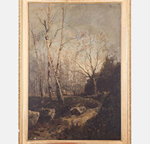
Emil Jakob Schindler
1842-1892
Poetic Realist landscape painter
Emil Jakob Schindler was born in 1842 in Vienna. He discovered the motifs for his paintings in the surrounding areas of Vienna, the Prater meadows, Vienna Woods, and the Wachau. Schindler is known for his idealized, poetic, and “atmospheric Impressionist” landscape paintings. Influenced by romanticism, his works suggest a harmony between man and nature. “Atmospheric Impressionism” was a movement in Austrian painting between 1870 and 1900 that had a decisive influence upon the artistic approach to landscape. This style turned away from the heroic landscapes of Historicism, yet on the other hand was to a large extent untouched by Secessionism. The term has been commonly used for this style of painting since about 1950 and conveys how artists sought to capture atmosphere in their pictures. Of course, the word “Impressionism” cannot be equated with the familiar art historical term. Indeed the compositions of the Atmospheric Impressionists often reflected a style more akin to Realism. Schindler died in 1892. His works are found in major museums throughout Europe. (Source: ArtDaily)
|
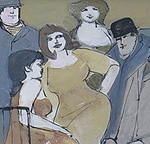
David Schneuer
1905-1987
Hungarian/German Post-Impressionist poster and mural artist
David Schneuer was born in 1905 in Austro-Hungary. He attended the Munchner Kunstgewerbeschule in Munich, Germany and then moved to Paris. In the 1920s, he worked as a stage designer and poster artist for Bertold Brecht in theaters in Berlin and Munich, greatly influenced by Kirchner, Grosz, and Beckmann. In 1932, he was imprisoned in Dachau as an artistic dissident. When he was released the following year, he immigrated to Palestine and settled in Tel Aviv. There his paintings, posters, and public murals were received with great enthusiasm. He died in 1987.
|
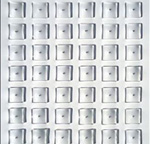
Johannes Jacobus Schoonhoven
1914-1994
German artist
Born in Delft, Germany in 1914, Schoonhoven studied at the Academy in The Hague from 1930-34. Jan is considered one of the most important Dutch artists of the 2nd half of the 20th century. He was an important figure in the development of reductionist/minimalist and conceptual art in the 1960’s and 1970’s. His black ink drawings and papier mache reliefs are included in the collections of many major international museums, including the Tate Gallery in London and The Museum of Modern Art in New York.
Until 1951, Schoonhoven made abstract drawings and watercolors. During the 1950’s, he was linked to CoBrA, an avant-garde movement of Nordic origin that advocated complete liberation of form and color. The art of this movement is characterized by violent brushstrokes, bright color, and clumsy figures. Later in life, Schoonhoven moved away from these traits, and instead adopted a meticulous, restrained, and monochromatic view. His black ink drawings are based on the principles of repetition and order, featuring patterns of lines and points. In 1967, he was awarded second place at the Sao Paolo Biennale. In 1968 and 1977, he participated in documenta 4 and 6 in Kassel. After he retired from a lifetime of working in the Dutch postal service in 1976, his work became less restricted, with his works continuing to be geometric, but losing their rigidity. He died in 1994.
|
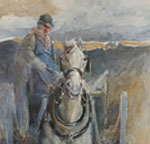
Henry August Schwabe
1843-1916
French Impressionist painter
Henry August Schwabe lived and worked in New Jersey and in Germany. He is known for painting portraits and landscapes, and for creating stained glass.
|
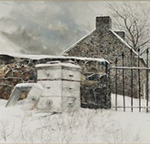
Peter Sculthorpe
b. 1948
Canadian-born Pennsylvania affiliated realist painter
Peter Sculthorpe was born in Ontario, Canada in 1948. From a young age he showed great artistic talent, which only continued to develop as he grew. In his senior year of high school he was awarded an art scholarship. Sculthorpe then studied at the Pennsylvania Academy of Fine Arts and the Hussian School of Fine art. His works can be found in both private and corporate colelctions, including General Electric, AT&T, and Nabisco. Sculthorpe’s paintings are in the permanent collections of the Delaware Art Museum, the William Penn Art Museum, and the Brandywine River Museum. His works have been exhibited at the American Watercolor Society, the National Academy of Design in New York, and others. He is known for watercolor and oil paintings of the historic region of Chester County, PA, as well as Maine and the Maritimes of Canada.
|
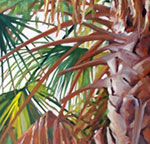
Mary Grayson Segars
-
20th Century American artist
Mary Grayson Segars grew up in Blacksburg, VA and attended the College of William and Mary with a major in biology. Art had always been a hobby of hers, but after moving to Beaufort with her husband in 1999, she decided to pursue it as a career. She teaches painting and drawing techniques and has participated in a number of juried festivals in Florida and South Carolina.
|
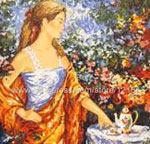
Igor Semeko
b. 1961
Russian painter
Born in Gomel, Belarus in Russia in 1961, Igor Semeko studied at the A. Hlebaw Minsk School of Art from 1976-1980. He specializes in decorative and applied arts in oil, and his works are characterized by rich textures and colors.
|
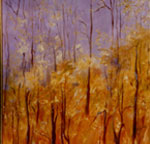
June Shatken
-
20th Century New Jersey Regional Artist
June Shatken takes her inspiration directly from observations of natural landscapes. Her paintings evoke the changing colors from moment to moment and season to season. A lifelong painter, she has painted landscapes around her, including many historic and hidden locations in Morris and Somerset counties. The artist has shown her work in private and group exhibits including Mendham Township Library, the Mortimer Gallery of the Somerset Art Association and the Diviana Gallery of Randolph, New Jersey.
|
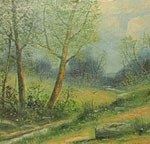
Victor Shearer
1872-1951
American Landscape Artist
Victor Shearer became a landscape and seascape painter in the traditional style and reportedly produced many paintings similar to each other, “selling them for a few dollars apiece on the streets of Reading.” He lived primarily in Reading, PA and before pursuing his career as an artist, he had a basket making business.
|
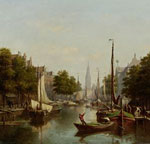
Andrew Sheerboom
1832-1880
Dutch artist
Andrew (Andries) Sheerboom (Sheerborn) was a Dutch painter who was born in 1832. He is known for genre paintings, paintings of royalty, the coast, and children. The artist died in 1880.
|
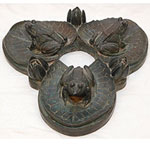
Eugenie Frederica Shonnard
1886-1978
Santa Fe, New Mexico affiliated sculptor, Realist painter
Born in Yonkers, New York, Shonnard was one of the pioneering American women sculptors of animal and Native American subjects. Eugenie Shonnard initially studied painting with Alphonse Mucha, but her interest in sculpture began with instruction from James Earle Fraser.
In 1925, she first visited New Mexico and modeled the Pueblo Indians. Enchanted by the landscape, she settled in Santa Fe in 1927, buying her life-long home. Alfred Morang, one of her peers in Santa Fe, wrote: "Miss Shonnard is able to go beyond the physical appearance of the object and invest her emotional reactions with the most profound forms.”
|
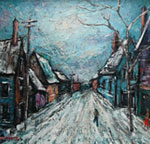
Harry Shoulberg
1903-1995
New York/Pennsylvania affiliated Expressionist painter and master printmaker
Harry Shoulberg was born October 25, 1903, in Philadelphia, Pennsylvania. He attended City College of New York where he studied biochemical engineering for three years before switching to fine arts in his last year. He continued his art education at the John Reed School, 1934–1935; the American Artists School, 1935–1937; and then privately at the studios of artists Sol Wilson, 1894–1974, and Carl Holty, 1900-1973.
A native of Philadelphia, Pennsylvania, Harry Shoulberg in 1944 became a member of the National Serigraph Society. His serigraphs have been exhibited at the Corcoran Gallery, the Library of Congress and the Audubon Society and have won prizes from the National Serigraph Society and the American Color Print Society. Shoulberg’s prints are in museum holdings at the Baltimore Museum of Art, The Carnegie Institute, the San Francisco Museum of Fine Arts, the Milwaukee Art Institute and the Smithsonian American Art Museum, Washington, D.C. Harry Shoulberg died April 15, 1995, in New York City at the age of 91.
|
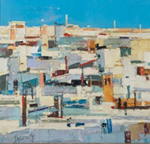
Andrew Shunney
1916-1978
American artist
Born in Attleboro, MA, Shunney studied at the Rhode Island School of Design and later moved to NYC where he attended the Art Students League. In 1946 he studied under Diego Rivera in Mexico for four years. After further studies in Paris and membership at the Salon d’Automne, he returned to Nantucket to pursue his career. His later work was influenced by the impasto style of Nicola Slimbari and Phil Hicken. Shunney showed at the Lobster Pot Gallery, Kenneth Taylor Galleries, and rented a studio on Straight Wharf. By 1971, Shunney had earned a solo exhibition at the Hammer Galleries in NYC. His works are represented in the Buehrle Collection in Zurich, Switzerland and several US Embassies through the Art in Embassies Program.
|
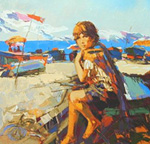
Nicola Simbari
1927-2012
Italian expressionist landscape and figure painter
Nicola Simbari was born in Calabria, Italy in 1927. Before he was thirteen, he decided to study art and enrolled at the Accademia delle Belle Arti, and when he was twenty-two, he opened his first studio in Rome. His works depict the sights of his childhood, including gypsies, café settings, fishing villages, and rustic scenes of the Italian countryside. Simbari knew success from a young age and was awarded the commission to paint murals for the Italian Pavilion at the 1958 World’s Fair in Brussels. His style is semi-abstract impressionist and was exhibited in the United States starting in 1959 in New York, Palm Beach, Los Angeles, Chicago, St. Louis, and Philadelphia. He died in 2012.
|
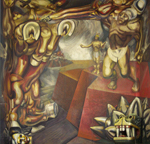
David Alfaro Siqueiros
1896-1974
Mexican muralist painter
David Alfaro Siqueiros was born in 1986 in Chihuahua.
He was a social realist painter, better known for his large fresco murals.
He was a member of "The Big Three", along with Diego Rivera and Jose
Clemente Orozco, who established "Mexican Muralism." He believed that
his artistic and political ventures were intricately intertwined. By 1921,
when he wrote his manifesto in Vida Americana, Siqueiros had already
been exposed to Marxism and saw the life of the working and rural poor
while traveling with the Constitutional Army. In the early 1930s, Siqueiros
produced a series of politically themed lithographs, many of which were
exhibited in the United States. As a muralist and an artist, Siqueiros
believed art should be public, educational, and ideological. He painted
mostly murals and other portraits of the revolution – its goals, its past,
and the current oppression of the working classes. His interest in the human form developed at the Academy in Mexico City. His accentuation of the angles of the body, its muscles and joints, can be seen throughout his career in his portrayal of the strong revolutionary body. In addition,
many works, especially in the 1930s, prominently feature hands, which
could be interpreted as another heroic symbol of proletarian strength
through work.
|
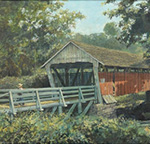
Eric Sloane
1905-1985
New York/ Santa Fe, NM affiliated landscape painter, illustrator and writer
Eric Sloane was born Everard Jean Hinrichs in New York City. His earliest childhood recollections reflect an avid interest in art which led to his first career as a sign painter. Setting out in 1925, Sloane traveled throughout the Northeast, where he felt an immediate rapport with and love for the history, culture and longstanding icons of early American architecture: covered bridges, barns and homes dating to the colonial era. Here Sloane felt the spirit of the early Nation yet felt it to be a vanishing theater of Untied States history. With interest and devotion unparalleled by any U.S. artist, Sloane would write and paint from just this perspective for the next sixty years.
Sloane worked his way across America painting signs and venturing further and further west. In 1926 he arrived in Taos, New Mexico. Just as Sloane had become enamored of the historical Northeast, he felt an instant affinity towards the natural beauty and heritage of the Southwest.
In Taos Sloane experienced life in a true artist's colony, working among painters such as Leon Gaspard and the members of Taos Society of Artists. He added his own footnote to their rich history by introducing to them his pioneer method of painting on masonite.
Upon his return to the East, Sloane began studies at the Art Students League in New York under John Sloan. Adopting the pseudonym Sloane (after his mentor's name) and taking his first name Eric (from the word America), the transformation from a young, inspired sign painter to an important American artist and author began.
The ultimate tribute to Sloane's insight and artistic ability in creating his wonderful skyscapes is his specially- commissioned mural in the National Air and Space Museum at the Smithsonian. The mural was no minor feat for an artist in his 71st year. Measuring seven stories high and half a city block long, Sloane completed the mural in less than two months.
|
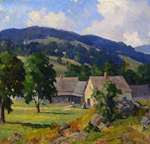
Marion Parkhurst Sloane
1876-1954
Massachusetts affiliated, Post-Impressionist landscape painter
Marion Parkhurst Sloane Webber Waitt (Mrs. George) was an art critic and landscape painter who was born in 1876 in Salem, MA and died in 1954 in Gloucester, MA.
Living most of her professional life in and around Boston after 1897, she studied at Boston's Museum School under T. Juglaris, Gallison and Louis Kronberg, kept a studio at the Fenway Studios on Ipswich Street and was a member of the Guild of Boston Artists, the Allied Artists of America, North Shore Art Association, Rockport Art Association, Grand Central Art Gallery Association, New American Watercolor Society, California Fine Arts Association and the Copley Society (1904).
She exhibited extensively using her maiden name and the married name Waitt. Her work is popular throughout the United States and especially in New York, Los Angeles and the New England area.
She is best recognized for her cloud-filled skies over robust landscapes done in the impressionistic manner. Her work is in the permanent collection of the Montclair Art Museum and she was an art critic for the Boston Journal.
|
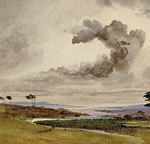
Frederick Albert Slocombe
1947-1920
English painter
The etched work of the Slocombe brothers, Charles Philip, Edward, and
Frederick was highly popular at the end of the nineteenth century.
Frederick Albert Slocombe lived in North London and became
established as a highly successful painter of landscape and rustic genre,
exhibiting widely at the Royal Academy and elsewhere for over fifty
years. As an etcher, Frederick Slocombe restricted his original work
to naturalistic landscape subjects; however, he was also an accomplished
reproductive printmaker, producing highly finished etchings after the
work of Joseph Farquharson, Alfred Parsons, B.W. Leader and others.
Most examples of Frederick Slocombe’s original etched works are only
known today from mass produced publications such as The Portfolio –
pencil signed proofs are rare.
|
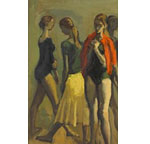
Moses Soyer
1899-1974
American Social Realist Painter
Moses Soyer was a significant figure in the American realist movement at the beginning of the 20th century. Soyer was born in Russia in 1899. He and his family, including his twin brother, Raphael Soyer, also a well-known artist, immigrated to New York in 1912.
Known primarily for his drawings and oil paintings, Soyer had his first solo exhibition in 1926 and was awarded a scholarship enabling him to travel to Europe to study drawing. During the 1930s, when the United States was at the height of the Great Depression, the Works Progress Administration commissioned Soyer to paint murals in government buildings throughout the country. Soyer’s art emphasized the depiction of the natural attitudes, thoughts, and gestures of individuals in performing everyday tasks. He was elected to the National Academy of Design in 1963 and in 1966 to the National Institute of Arts and Letters.
|
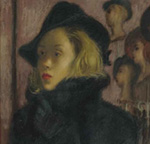
Raphael Soyer
1899-1987
Russian/American genre painter and printmaker
Raphael Soyer, born in Tambov, Russia, emigrated to the US in 1912, where he studied at the Art Students League. He studied with Guy Pene du Bois taking up urban subjects of the Ashcan school. He showed regularly beginning in 1930 at American museums and began teaching art in 1930 in New York. His work is in numerous museums including MOMA, The Corcoran Gallery of Art, Fogg Art Museum, The Phillips Collection and many others.
|
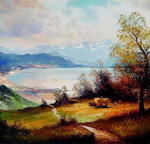
Helmut Stadelhofer
1914-1979
German landscape painter
Helmut Stadelhofer was born in 1914 in Konstanz-Wollmatingen, Germany. From 1929-1932, he taught decorative and fresco painting. In 1939 he volunteered to join the mountain hunters and was wounded in Lviv in 1941 when he was dismissed from the Wehrmacht. From 1943 - 1945 he studied painting under Professor Harald Bengen in Berlin, he studied at the Art Academy of Munich under Professor Max Meiershofer, and he took private lessons with Sohn-Skuva and Julius Huther. In 1945, he was admitted as a member of the Professional Association of the Fine Arts Reference and opened a studio in Munich. In 1950, he began to take study trips throughout Europe and even to the United States. He died in 1979.
|
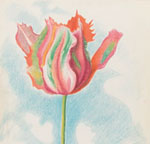
Joseph Stella
1877-1946
Italian born American affiliated Modernist painter known for figure, landscape and still life subjects
Joseph Stella was born in Italy, and moved to New York City in 1896. He made a name for himself in the early 1900’s as a Social-Realist illustrator. In 1912, however, he spent a year in Paris where he was greatly influenced by Fauvism, Cubism, and Futurism and made a radical change to a more abstract style.
Stella returned to New York to exhibit several paintings in the 1913 Armory Show. The artist, along with recent New York arrivals Marcel Duchamp and Man Ray, became associated with the Walter and Louise Arensberg group. His work from this period catapulted Stella from obscure illustrator to that of famous American Modernist.
His work is included in the collections of most major American museums of art, including the Whitney Museum of American Art, the Museum of Modern Art, NY and the Metropolitan Museum of Art, NY.
|
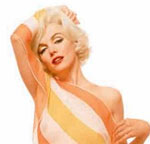
Bert Stern
1929-2013
American photographer
Bert Stern was born in Brooklyn, New York in 1929 he was inspired to become a photographer by an Irving Pen photograph in a magazine. He dropped out of school and got a job in the mailroom at Look magazine where he befriended the director Stanley Kubrick. He served in the Korean War as a cameraman and photographer. Returning to the U.S. he quickly became recognized as a commercial photographer.
He is best known for his candid photographs of film stars, in particular, his photographs of Marilyn Monroe taken in 1962 when he was a contract photographer for Vogue magazine. He took over 2,500 photographs of the star over the course of three sessions at the Hotel Bel-Air. These are some of the last photographs taken of the star.
Other notable people photographed by Stern include Twiggy, Gary Cooper, Elizabeth Taylor as Cleopatra, Madonna.
He married the ballerina Allegra Kent in 1959 the married ended in divorce and 2009 he married the documentary director Shannah Laumeister, who he had met while being filmed for her documentary Bert Stern: Original Madman. He died on June 26, 2013.
|
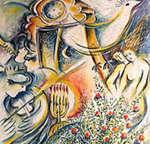
Zamy Steynovitz
1951-2000
Polish modern abstract genre and figure painter
Zamy Steynovitz was born in Liegnitz, Poland in 1951, and immigrated to Isreal with his family in 1957. From a young age, Zamy had an interest in art, winning a national art prize before immigrating. He studied at the Art School in Tel Aviv and at the Royal Academy of London. His choice of subjects was strongly influenced by Jewish tradition and folklore, but he also enjoyed creating scenes of Paris, flowers, angels, and circuses. Some of his works suggest an artistic style influence of Marc Chagall. In the 1980s, Steynovitz visited South America and was influenced by his new surroundings which were bright and colorful, causing him to alter his palette. He worked tirelessly in the creation of paintings, serigraphs, and embellished serigraphs until his death in 2000.
|
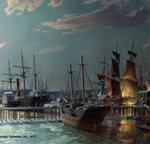
John Stobart
b. 1929
Marine painter
John Stobart was born in 1929 in Leicester, England. He showed an early aptitude for creativity, and his father enrolled him in Derby College of Art in 1946. He received a scholarship to London’s Royal Academy Schools. A voyage by passenger-cargo vessel to South Africa sparked Jonh's interest in maritime subjects, a topic he pursued for more than fifty years. In the mid-1960s his focus became historical paintings of sailing scenes. In 1965 he visited the United States with four paintings of sailing ships. The same day he arrived in New York, he was offered a one man show by the Wunderlich family who had founded and owned Kennedy Galleries. With growing popularity, Stobart initiated the idea of publishing limited edition prints of his more important works. Stobart established Maritime Heritage Prints, Inc. in 1976 so that he could control the quality of the prints.
|
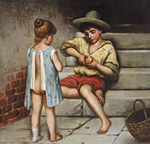
Ferdinand Jakob von Stoopendaal
1850-1930
Swedish American portrait painter
Ferdinand Jakob von Stoopendaal was bown in Linkoping, Sweden. His father Henrik was a well-known artist, as were several of his siblings. Ferdinand attended the Swedish Royal Academy of Fine Arts in Stockholm from 1870-1878. There he joined a group of fellow students who were opposed to new artistic trends, including Impressionism. In March of 1892 he decided to work in America and traveled on the Tingvalla line steamer Norge with his younger sister and younger brother. He arrived in New York and moved to Brooklyn, Long Island. He worked as an illustrator for New Illustrated Magazine while also teaching at Shields School of Art. He died in July of 1930. The Swedish Royal Academy of Arts holds more than a hundred of his drawings, while the largest number of his works reside in private collections throughout Europe and the United States.
|
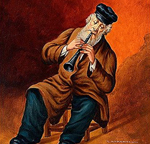
Abraham Straski
1903-1987
Polish Judaic themes figures and genre scene painter
Abraham Straski was a Polish-born painter who emigrated to the United States after surviving Nazi concentration camps during WWII. His works typically depict rabbis in rooms of warm, rich colors. Growing up as a devout follower of the Jewish faith, he knew many rabbis in his community who taught him violin, cello, and the teachings of the Torah. When his family was forced into concentration camps, he would find small scraps of paper and make tiny sketches of his teachers, continuing this practice on a much larger scale after his freedom.
|
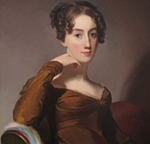
Thomas Sully
1783-1872
American portraitist, historical and landscape artist
Born in Horncastle, Lincolnshire, England to actor parents, Thomas Sully began his artistic career painting miniatures in Charleston, SC. He later received advice from such established artists as John Trumbull and Gilbert Stuart before returning to England for a year of study with Sir Thomas Lawrence and others. Sully settled in Philadelphia in 1810, where he soon established himself as America’s leading portraitist, a reputation he maintained for more than fifty years.
Sully was the creator of a romantic style of portraiture-elegant, refined, and immensely popular. Some consider him the most admired portraitist of the Romantic era in the United States. Sully produced over twenty-six hundred works, approximately two thousand of which were portraits. The remainder was landscapes, genre and thematic figurative works. Sully’s portraits are in the collections of The Philadelphia Museum of Art, The Pennsylvania Academy of Fine Art, The Metropolitan Museum of Art, The Boston Museum of Art, The National Portrait Gallery and Yale University.
|
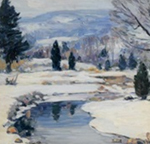
Ivan F. Summers
1889-1964
American landscape painter and etcher
Ivan F. Summers was an important Impressionist whose home was
in Woodstock, New York for most of his life. Born in Illinois, he studied
at the St. Louis School of Fine Arts in 1910, and won three awards in the
St. Louis Art Guild Exhibitions 1914-1919, as well as a prize in the Art Students League, NYC in 1916. By 1930, Summers became the Director
at the ASL’s Summer School at Woodstock. In 1932, he was selected as
a WPA artist, creating a portfolio of etchings of historical landmarks. A
major retrospective exhibition of his work was presented in 1989 at Kollar
& Davidson in Seattle WA.
|
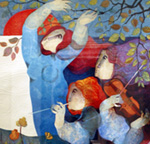
Alvar Sunol Munoz-Ramos
b. 1935
Spanish figure artist
Alvar Sunol Munoz-Ramos was born in 1935 in ontgat, a Catalan fishing village on the Mediterranean coast near Barcelona. He started painting when he was twelve and when he was seventeen, he was accepted at the Escuela Superior de Bellas Artes de San Jorge. He gave his first solo show before he graduated at Galleries Layetana in 1957. When he was eighteen, he entered a painting in a competition for the Young Painters Prize sponsored by the City of Barcelona, which he won, and which is now in the permanent collection of the Museum of Modern Art in Barcelona. Alvar’s paintings were exhibited in the United States for the first time at Monede Gallery in New York in 1962. His first original lithographs were produced for a one-man show at Gelerie Drouant in 1963. Alvar continues to work in a variety of mediums.
|
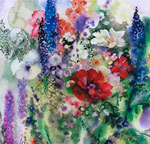
Jan Swift
-
American 20th century watercolor artist
Jan Swift is a local New Jersey watercolor artist who is known for her participation in numerous one-woman shows and group shows in New Jersey. Her award-winning watercolors include florals, architectural settings, landscapes and still life. She has won numerous awards for her work and is represented in several private and corporate collections and at Gallery 23 in Blairstown.
|
| |
|
| |
|
|


